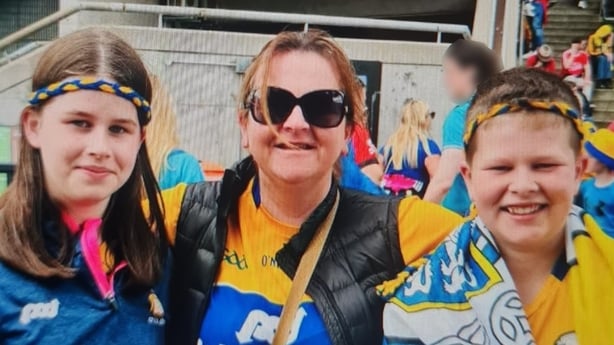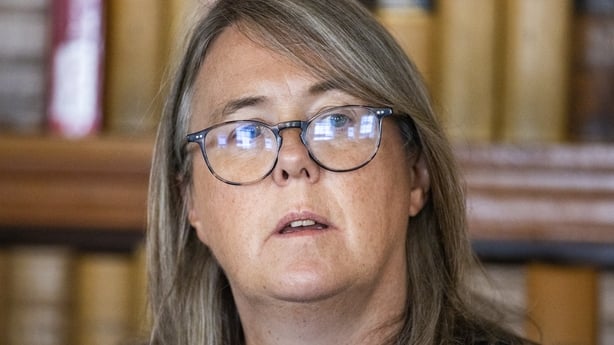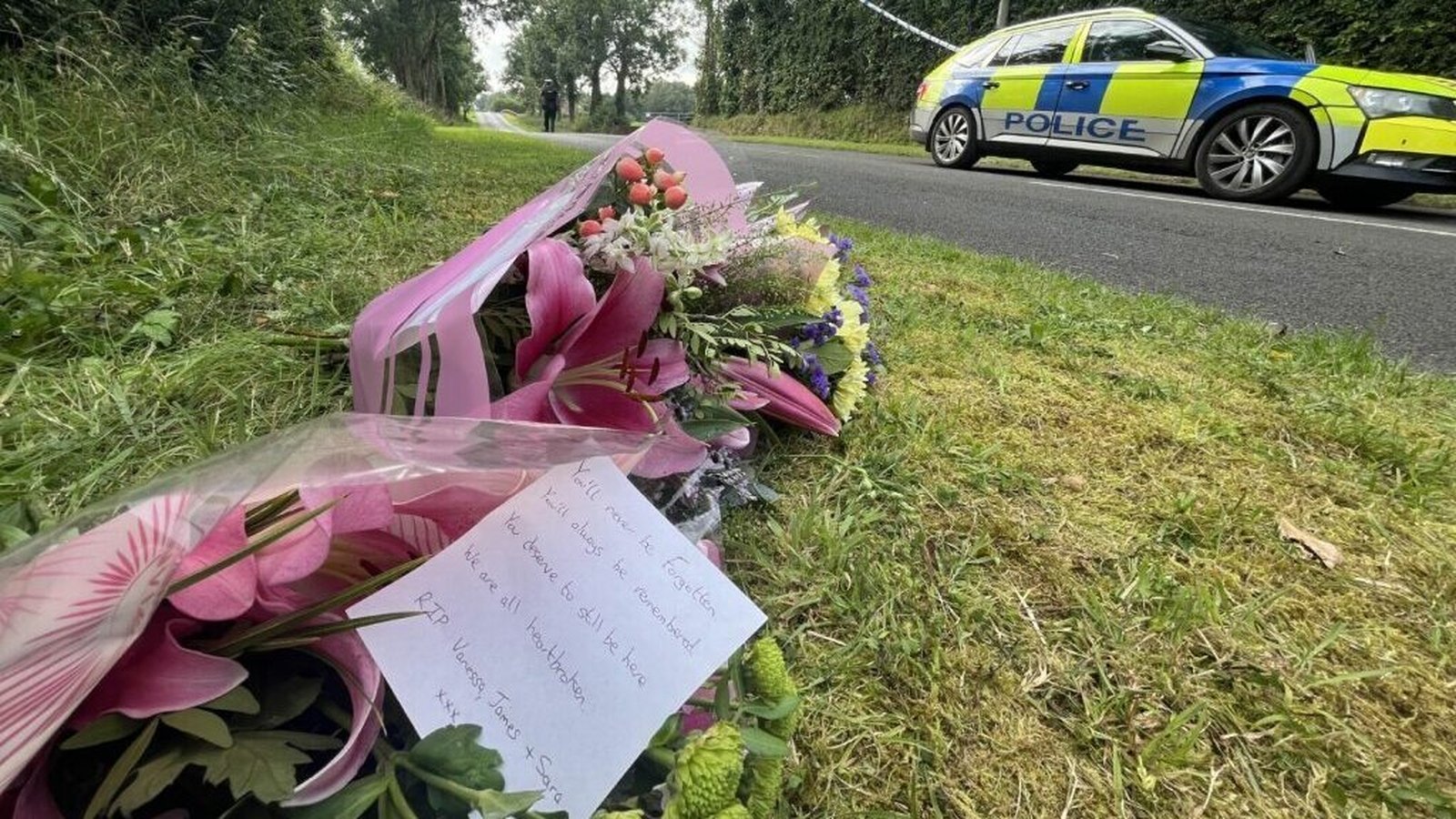The message on the bouquet left by a rural roadside was simple and poignant. “You should still be here,” it read.
The flowers had been left at a police cordon on 24 July where officers were protecting the integrity of a triple murder scene.
The previous day near Maguiresbridge in Co Fermanagh, Vanessa Whyte, who worked as a veterinary surgeon for the Department of Agriculture, and her children 13-year-old Sara and 14-year-old James Rutledge had been found shot in their home.
Ms Whyte and one of her children were pronounced dead at the scene, while the second child died later that day in hospital.
Vanessa’s husband, Ian Rutledge, who died five days later in hospital from a gunshot, is suspected of carrying out the killings.
As friends and neighbours gathered on 1 August for the removal of 45-year-old Vanessa and her children to her family home in Barefield in Co Clare for burial, a priest said the killings had “shocked this community and this country to the core”.

Vanessa Whyte with her children Sara Rutledge and James Rutledge
Vanessa and her children had become the latest victims in a grim rollcall of domestic violence that is particularly prevalent in Northern Ireland – dubbed one of the most dangerous places in Europe for women.
Since 2020, 28 women have been murdered by partners, former partners or family members.
In all but one case, men were responsible or have been charged in connection with the cases.
Attempts are being made to tackle the consistent targeting of women.
The Stormont Executive has a strategic framework to stop violence against women and girls. The PSNI has an action plan aimed at doing the same.
There are common themes, increasing awareness of the scale of the problem, bolstering victims’ confidence to report, cracking down on perpetrators.
But it is a huge undertaking.
The murders are just the visible tip of a massive iceberg of physical and psychological abuse, harassment, coercive control, stalking and other behaviours designed to undermine and isolate women.
“How do I explain to someone that another person has systematically over the period of weeks, months and years completely destroyed your mental health.”
Dr Susan Lagdon is a University of Ulster academic who was commissioned by Stormont to produce a study that would inform its Executive strategy.
She surveyed more than 500 women – virtually all of them had experienced some form of violence or abuse in their lifetime, often beginning in childhood.
Many had not reported what they were enduring.
“Those behaviours that start early on, things like psychological and emotional abuse, threatening behaviour, putting someone down, chipping away at a person’s self-worth, they happen over time, slowly, and they remove someone’s confidence within themselves to speak out,” Dr Lagdon said.
Another factor in under-reporting was that women who had did not bear the scars of physical assault were often reluctant to go to the authorities.
Dr Lagdon said: “If I walk through the door with a black eye or a broken bone everyone can see the harm that has been caused to me.
“But how do I explain to someone that another person has systematically over the period of weeks, months and years completely destroyed your mental health.”

Chief Justice Siobhan Keegan said she would encourage some cases to be brought before a higher court
That context of under-reporting makes the recorded statistics on domestic violence all the more alarming.
According to the most recent PSNI figures there were more than 29,000 incidents of domestic violence in 2024/2025 – a 9% decrease on the previous year.
Linked to the issue of reporting and the lack of it, is how the justice system deals with women who take cases and the extent to which courts provide an effective deterrent through sentencing.
There have been advances on both fronts, but further work is needed.
Northern Ireland’s Chief Justice Siobhan Keegan spoke about it in an interview with UTV earlier this year.
She was asked why, with 1,900 convictions for domestic abuse in 2023, two thirds of perpetrators had received non-custodial sentences and only a very small proportion had received sentences of more than a year.
She explained that most cases had been brought to the lower, magistrates court, which had a maximum custodial sentence of one year – with 50% remission.
She said she would encourage some cases to be taken before a higher court.
“I have said that in a number of cases recently, that particularly with persistent domestic violence, prosecutors should actively consider these cases going to the Crown Court where the Crown Court judge has the ability to pose a heftier sentence,” Ms Keegan said.
Apart from the issue of sentencing, the justice system needs to do more to support women who do go to court. At present it can be a lengthy process and not sufficiently victim centered.
‘Behind closed doors’ mentality
Some women report being retraumatised by the court process, left feeling that it is them on trial not the perpetrator and that the onus is on them to prove they have been a victim.
Making real improvements to what everyone agrees is a complex issue has been described as a “massive jigsaw” requiring societal change.
No longer can people afford to adopt a “behind closed doors” mentality.
Education will be key and not just in the schools. A public awareness campaign is being rolled out so that everyone can spot the tell-tale signs of domestic abuse and potentially become part of the response.
Troubles’ role in levels of femicide
Which brings us to the question of whether the Troubles and 30 years of violence in Northern Ireland plays any role in the levels of femicide and other forms of violence against women and girls.
Dr Lagdon believes there is a link – that over the years people became accustomed to the use of violence.
“I think that we are trying as a society to recover from that and that includes the normalisation of the use of violence.
“We’re not shocked by the use of such behaviour and I do wonder if that is a form of habituation in some way – that we have got so used to those behaviours that we haven’t yet got to a point just yet where we should be in calling them out in the way that we should,” she said.
The one positive is that violence against women and girls is an issue that everyone is now talking about, the judiciary, the politicians, the media and the public.
BBC Northern Ireland News Online has done some important journalism, collating the stories and the pictures of the 28 women murdered in the last five years, keeping their names, faces and stories in the public consciousness alongside the statistic.
Vanessa Whyte, smiling, in her GAA club hat and top, is the latest to look out from the page.
